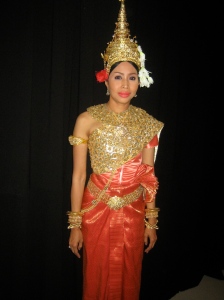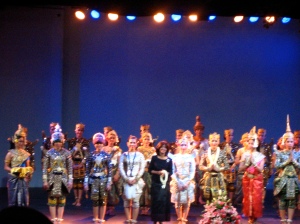Today after rehearsal, we had a very special Buddhist blessing ceremony for the theatre called Sompeh Kru. We all gathered on the stage of the Chenla where an altar was assembled bearing offerings of jasmine, fruits, flowers, incense and candles, food plates of chicken, fish, and most importantly a pig’s head. I don’t know how this happened, but I managed to park myself right in front of it. Most everyone wore white and there was chanting and our musicians playing.
Prayers were offered to the late masters of all the Cambodian artists, many of whom lost their teachers in the Khmer Rouge genocide barely 30 years ago as the KR targeted all the artists first. I was particularly touched by the offering of the dancers, as I’ve gotten pretty close with several members of the Cambodian company. It was really exciting to see them do their amazing work with the intent and focus they had. It’s hard to imagine the stories my fellow castmembers have lived through, for it is the Cambodian way to be quite stoic.
In the several times when I’ve broken down in rehearsal, they’ve hugged me and patted my cheeks but encouraged me to be more forbearing. I’ve had a hard time explaining to them that as a western actor, the very goal is to be able to unzip yourself and have free access to all those parts of yourself most laypeople try to put way… (Though still working on better access to that leverage switch- I think all the crying I’m doing here is aging me.) But in this emotional offering to their late teachers, their energy and intent was palpable.
At the end of the ceremony, white string braclets soaked in holy water were tied on to every participant of the ceremony. We all came together and congratulated and hugged each other. These bracelets are to be worn (in similar fashion of the red string bracelets giving by Buddhist monks at the Wats) until they fall off, or it is very unauspicious. I hope mine stays on for a year, as they sometimes do! To further punctuate the ceremony and bridge the many worlds present, our choreographer Sean Curran lead a western style prayer and said many words of inspiration as the entire group held hands. I was sitting between our composer Him Sophy and Cambodia Living Arts founder Arn Chorn Pond. I felt my own consciousness and energy raise from the tremendous life force of these two amazing people as well as from the group around me. It was honestly an event I’ll cherish for my entire life.








